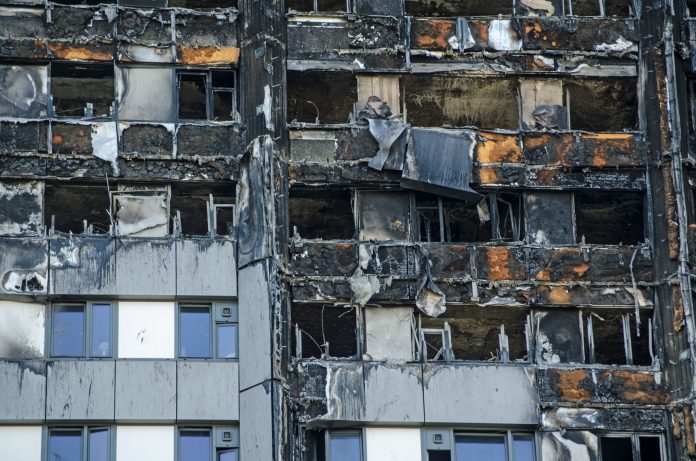Mark Clinton, national head of construction and engineering at Irwin Mitchell, examines the current state of play following the government’s latest announcements regarding the cladding crisis
One of the highest profile and most pressing problems waiting on Michael Gove’s desk when he arrived as the new secretary of state at the Department for Levelling Up, Homes & Communities was the fire safety crisis (commonly called a cladding crisis, but the problem goes beyond cladding). It quickly became apparent that he was not happy with where matters stood and, many of us would say, quite rightly so.
Prior to his arrival, the focus had been on providing funding to get the relevant buildings made safe and for recipients of funding to pursue remedies against those responsible for the defects to recover what the taxpayer had spent putting them right.
Building safety has fallen short after Grenfell
His predecessor last year announced a loan scheme for buildings between 11m and 18m in height to enable those buildings to be remediated. Although the programme can rightly be criticised for having been slow and poorly thought-out and the loan proposal was unpopular, the priority of getting the buildings made safe was surely the right one.
The secretary of state’s announcement to the House of Commons on 10 January 2022, and his responses to members’ questions in the hour that followed, marked a change of approach and priorities. While he announced that the next phase of the Building Safety Fund will start shortly (presumably a reference to the additional funding announced by his predecessor last year and about which little or nothing has been heard since), he also announced that the proposed loan scheme is to be scrapped.
Developers to pay the price of defective buildings
The new mantra is that the polluter must pay and that means that the government will be asking developers to fund the remediation of defective buildings and, if they do not agree, they will be forced to do so, by legislation if necessary.
In announcing that leaseholders would not have to pay if they have not already done so when the new measures come in, he also swept in freeholders as if they are “polluters” too.
Many freeholders had nothing to do with the original construction of the buildings they own, having acquired them later, subject to the leases that had already been sold and on the basis of leaseholders’ service charge obligations. Those freeholders are also innocent purchasers caught up in a problem created by others.
The handling of this issue so far has been characterised by what appears to be a failure to recognise the complex legal and commercial background to it and the now common practice of making ear-catching policy announcements without having worked out in any detail how the policy objective will be achieved. This risks the proposal turning out to be unworkable and being scrapped (like the loan scheme) or poorly worked out solutions that drag on and result in bad legislation. That would inevitably lead to delay to the remediation of buildings and prolongation of the worries of leaseholders living in unsafe and unsellable flats.
The responsibility for the problem does not rest with developers as a class or even solely with those developers whose buildings are defective. While the ongoing Grenfell Inquiry may help show where responsibility lies, the original design and construction will have been the responsibility of supply chains. All this happened under a regulatory system for which responsibility rests with the government.
If developers are to be forced to foot the bill, how will others in the supply chain be brought into the equation? It is proposed that there will be an extended 30-year limitation period for the bringing of claims against developers (a 15-year period for claims under the Defective Premises Act 1972 had previously been announced).
Will a similar period apply to claims by developers against supply chain members? Even that would not help where a supply chain member is no longer in existence, leaving the party immediately above it in the chain liable. Nor will it help where a supply chain member who had adequate insurance for the original limitation period can no longer obtain it.
Retrospective legislation is very rare in the United Kingdom. That is for the very good reason that it contravenes our cherished “rule of law” and is inherently unfair.
If developers do not agree to foot the bill, the government should think very carefully before remedying one injustice with another. Parties entered into transactions for the construction, sale and purchase of the buildings on specific legal and commercial terms and within a specific legal framework. The idea of moving the goalposts after the event is deeply troubling.
The announcement also picked up on another theme in recent comments from ministers to the effect that some buildings have wrongly been classified as unsafe. “Misinterpreted” guidance has since been withdrawn and assessors are to be indemnified against liability. That should mean that some leaseholders no longer have the problems of disruptive works and the service charge bills for them, and their homes should be more readily saleable. Why has it taken so long to reach the conclusion that the guidance was being incorrectly interpreted and why was it open to misinterpretation? There is a theme here.
The secretary of state said he will return to the Commons with an update before Easter. By then it will be almost five years since Grenfell. We can only hope that the progress made in the next two months or so will be significant.
The construction industry must not treat this as someone else’s problem. We must ask searching questions about how we arrived at this point. Why do so many buildings have dangerous external wall systems and why are firebreaks routinely missing or incorrectly installed? Things must be seriously wrong in an industry where that can happen. Skills, lowest price tendering, unrealistic programming, attitudes, risk-dumping, regulation and oversight and much more must come under review.

National head of construction and engineering
Irwin Mitchell
Tel: +44 (0)370 1500 100







![[Video] Enhancing safety with fire doors: A case study of Marina Care Home](https://www.pbctoday.co.uk/news/wp-content/uploads/2025/06/maxresdefault-218x150.jpg)






![[VIDEO] Making DorTrak reports easy to read with Fireco Inspecting fire doors at Fireco, firedoor technology, 2023](https://www.pbctoday.co.uk/news/wp-content/uploads/2024/04/JPZ_2364-web-218x150.jpg)